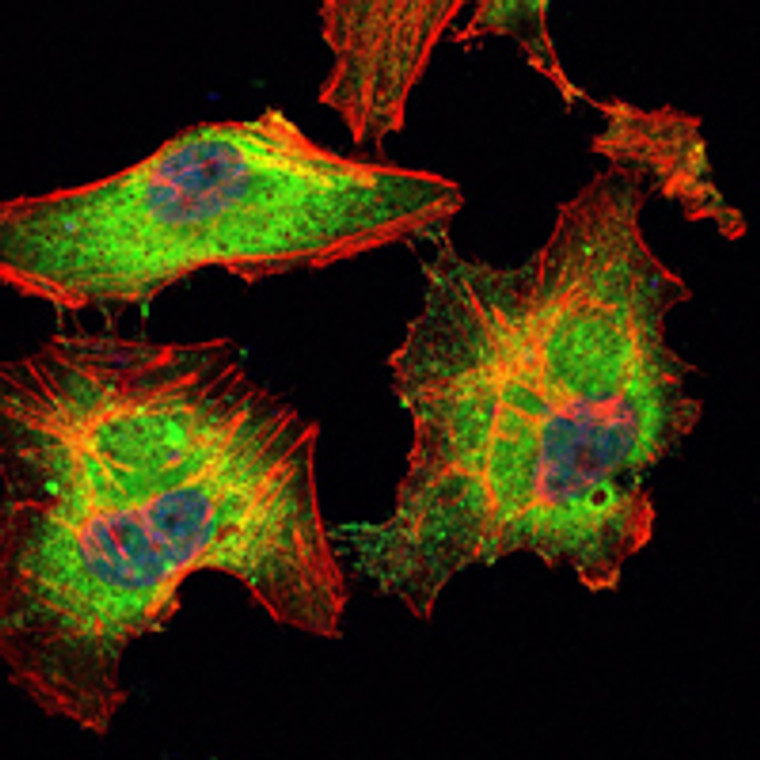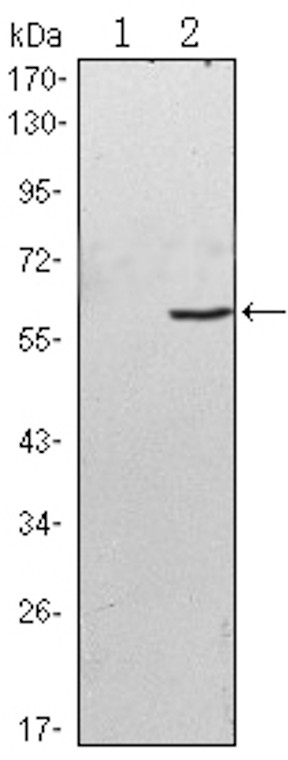| Host: |
Mouse |
| Applications: |
WB/IF/FC/ELISA |
| Reactivity: |
Human |
| Note: |
STRICTLY FOR FURTHER SCIENTIFIC RESEARCH USE ONLY (RUO). MUST NOT TO BE USED IN DIAGNOSTIC OR THERAPEUTIC APPLICATIONS. |
| Short Description: |
Mouse monoclonal antibody anti-Tyrosine-protein kinase Blk is suitable for use in Western Blot, Immunofluorescence, Flow Cytometry and ELISA research applications. |
| Clonality: |
Monoclonal |
| Clone ID: |
1E6 |
| Conjugation: |
Unconjugated |
| Isotype: |
IgG1 |
| Formulation: |
Liquid in PBS containing 0.03% Sodium Azide, 0.5% BSA, 50% Glycerol. |
| Purification: |
Affinity purification |
| Dilution Range: |
WB 1:500-1:2000IF 1:200-1:1000FC 1:200-1:400ELISA 1:10000 |
| Storage Instruction: |
Store at-20°C for up to 1 year from the date of receipt, and avoid repeat freeze-thaw cycles. |
| Gene Symbol: |
BLK |
| Gene ID: |
640 |
| Uniprot ID: |
BLK_HUMAN |
| Specificity: |
Blk Monoclonal Antibody detects endogenous levels of Blk protein. |
| Immunogen: |
Purified recombinant fragment of human Blk expressed in E. Coli. |
| Post Translational Modifications | Phosphorylated on tyrosine residues after antibody-mediated surface engagement of the B-cell antigen receptor (BCR). Ubiquitination of activated BLK by the UBE3A ubiquitin protein ligase leads to its degradation by the ubiquitin-proteasome pathway. |
| Function | Non-receptor tyrosine kinase involved in B-lymphocyte development, differentiation and signaling. B-cell receptor (BCR) signaling requires a tight regulation of several protein tyrosine kinases and phosphatases, and associated coreceptors. Binding of antigen to the B-cell antigen receptor (BCR) triggers signaling that ultimately leads to B-cell activation. Signaling through BLK plays an important role in transmitting signals through surface immunoglobulins and supports the pro-B to pre-B transition, as well as the signaling for growth arrest and apoptosis downstream of B-cell receptor. Specifically binds and phosphorylates CD79A at 'Tyr-188'and 'Tyr-199', as well as CD79B at 'Tyr-196' and 'Tyr-207'. Phosphorylates also the immunoglobulin G receptors FCGR2A, FCGR2B and FCGR2C. With FYN and LYN, plays an essential role in pre-B-cell receptor (pre-BCR)-mediated NF-kappa-B activation. Contributes also to BTK activation by indirectly stimulating BTK intramolecular autophosphorylation. In pancreatic islets, acts as a modulator of beta-cells function through the up-regulation of PDX1 and NKX6-1 and consequent stimulation of insulin secretion in response to glucose. Phosphorylates CGAS, promoting retention of CGAS in the cytosol. |
| Protein Name | Tyrosine-Protein Kinase BlkB Lymphocyte KinaseP55-Blk |
| Database Links | Reactome: R-HSA-8939245Reactome: R-HSA-983695 |
| Cellular Localisation | Cell MembraneLipid-AnchorPresent And Active In Lipid RaftsMembrane Location Is Required For The Phosphorylation Of Cd79a And Cd79b |
| Alternative Antibody Names | Anti-Tyrosine-Protein Kinase Blk antibodyAnti-B Lymphocyte Kinase antibodyAnti-P55-Blk antibodyAnti-BLK antibody |
Information sourced from Uniprot.org
12 months for antibodies. 6 months for ELISA Kits. Please see website T&Cs for further guidance








